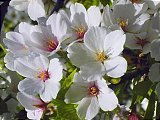cherry tree varieties
A large majority of cherry trees in Japan are of the Somei Yoshino and Yamazakura varieties. But in total, over one hundred cherry tree varieties can be found in Japan.
There are several characteristics that differ between the various cherry tree varieties. Some of the obvious ones, that can also be easily recognized by beginners, are listed below:
Number of petals:
Most wild trees, but also a lot of cultivated tree varieties have blossoms with five petals. However, some species have blossoms which consist of more than five petals, such as ten, twenty or more. Trees with blossoms of more than five petals are called yaezakura.
 5 petals (e.g. Oshimazakura) |  about 20 petals (e.g. Ichiyo) |  about 100 petals (e.g. Kikuzakura) |
Color of the blossoms:
Most varieties produce lightly pink to pure white blossoms, but there are also cherry trees with dark pink or slightly yellowish blossoms. The color of the blossoms of some varieties is also changing while they are in bloom, from white to pink, for instance.
 white blossoms (e.g. Shogetsu) |  pink blossoms (e.g. Kanzan) |  yellowish blossoms (e.g. Ukon) |
The fresh leaves:
In case of early blooming trees, the fresh leaves usually do not appear until after full bloom, which gives the trees an attractive, homogenous look while they are in full bloom. In case of later blooming trees, the leaves usually appear before the blossoms, giving the trees a more heterogeneous look. Furthermore, the color of the fresh leaves differs between the varieties. In most cases, the fresh leaves are green, coppery brownish or something in between.
Time of blooming:
Most cherry tree varieties carry blossoms in spring. However, there are a few varieties, which bloom in late autumn and during the winter months. Yaezakura, i.e. cherry trees with blossoms of more than five petals, are typically the last ones to open their blossoms, about two to four weeks after most five-petaled species. Read more about when cherry trees are in bloom.
Form of the tree:
Cherry trees display various growing habits and come in different shapes and forms: triangular, columnar, V-shape, weeping, flat-topped, etc. Weeping cherry trees are called shidarezakura.
Some cherry tree varieties, found in Japan, are listed below. The blooming periods shown refers to the situation in Tokyo.
  | Somei Yoshino (Yoshino Cherry) late March, early April Cultivated during the Edo Period, the Somei Yoshino is by far the most numerous cherry tree in Japan. Somei Yoshino trees come with slightly pink, almost white, 5-petaled blossoms. |
  | Yamazakura late March, early April Yamazakura is a wild, native cherry tree variety of Japan, which typically grows in mountainous areas. The blossoms are slightly pink and have five, relatively small petals. |
  | Shidarezakura (Weeping Cherry) late March, early April Shidarezakura are weeping cherry trees, i.e. they have drooping branches. There are trees with blossoms of five petals and trees with blossoms of more than five petals. The latter are called Yaeshidarezakura. |
  | Ichiyo mid April The Ichiyo has about twenty, lightly pink petals per blossom. The fresh leaves are green. |
  | Ukon mid April The Ukon has about 10-20 petals per blossom and coppery leaves. Ukon trees are easily recognized by their blossoms' characteristic, yellowish color. |
  | Kanzan mid to late April Among the many yaezakura varieties, the Kanzan is one of the most numerous. One Kanzan blossom consists of as many as 30-50 pink petals. The fresh leaves are coppery brown. |
  | Fugenzo mid to late April The Fugenzo is a late blooming yaezakura with about 30-40 petals per blossom. White to slightly pink when they open, the blossoms turn into a darker pink over time. The fresh leaves are coppery brown. |
  | Shogetsu mid to late April The Shogetsu is a late blooming yaezakura with relatively large, white blossoms of about 20-30 petals. The fresh leaves are green. |
  | Kikuzakura (Chrysanthemum Cherry) late April, early May The Kikuzakura has as many as one hundred petals per blossom! It is also one of the latest blooming trees. In fact, by the time the blossoms are in bloom, the fresh leaves have already developed almost completely and are somewhat hiding the blossoms. |
Labels: Hanami



0 Comments:
Post a Comment
Subscribe to Post Comments [Atom]
<< Home